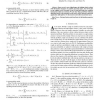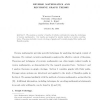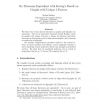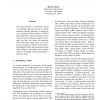121
Voted
SIGECOM
2011
ACM
14 years 3 months ago
2011
ACM
We introduce a matching model in which agents engage in joint ventures via multilateral contracts. This approach allows us to consider production complementarities previously outs...
108
Voted
TFS
2008
14 years 11 months ago
2008
Some errors in our original paper in defining relative reduct with information measures are pointed out in this paper. It is shown that in our original work, Theorems 10 and 19 hol...
120
Voted
MLQ
1998
15 years 6 days ago
1998
We examine a number of results of infinite combinatorics using the techniques of reverse mathematics. Our results are inspired by similar results in recursive combinatorics. Theor...
111
click to vote
EJC
2002
15 years 10 days ago
2002
A subgraph H of a graph G is gated if for every x V(G) there exists a vertex u in H such that dG (x, v) = dG (x, u) + d G (u, v) for any v V(H). The gated amalgam of graphs G 1 an...
118
Voted
ARSCOM
2004
15 years 12 days ago
2004
We show that several known theorems on graphs and digraphs are equivalent. The list of equivalent theorems include Kotzig's result on graphs with unique 1-factors, a lemma by...
119
Voted
CJ
2006
15 years 18 days ago
2006
Mathematics is facing a dilemma at its heart: the nature of mathematical proof. We have known since Church and Turing independently showed that mathematical provability was undeci...
140
click to vote
CCA
2009
Springer
15 years 4 months ago
2009
Springer
Abstract. In this paper we study a new approach to classify mathematical theorems according to their computational content. Basically, we are asking the question which theorems can...
FSTTCS
1994
Springer
15 years 4 months ago
1994
Springer
We review the past ten years in computational complexity theory by focusing on ten theorems that the author enjoyed the most. We use each of the theorems as a springboard to discus...
136
Voted
MKM
2005
Springer
15 years 6 months ago
2005
Springer
Abstract. The relationship between theorems and lemmas in mathematical reasoning is often vague. No system exists that formalizes the structure of theorems in a mathematical librar...
102
Voted
TARK
2007
Springer
15 years 6 months ago
2007
Springer
This paper provides a set-theoretic model of knowledge and unawareness, in which reasoning through theorems is employed. A new property called Awareness Leads to Knowledge shows t...




